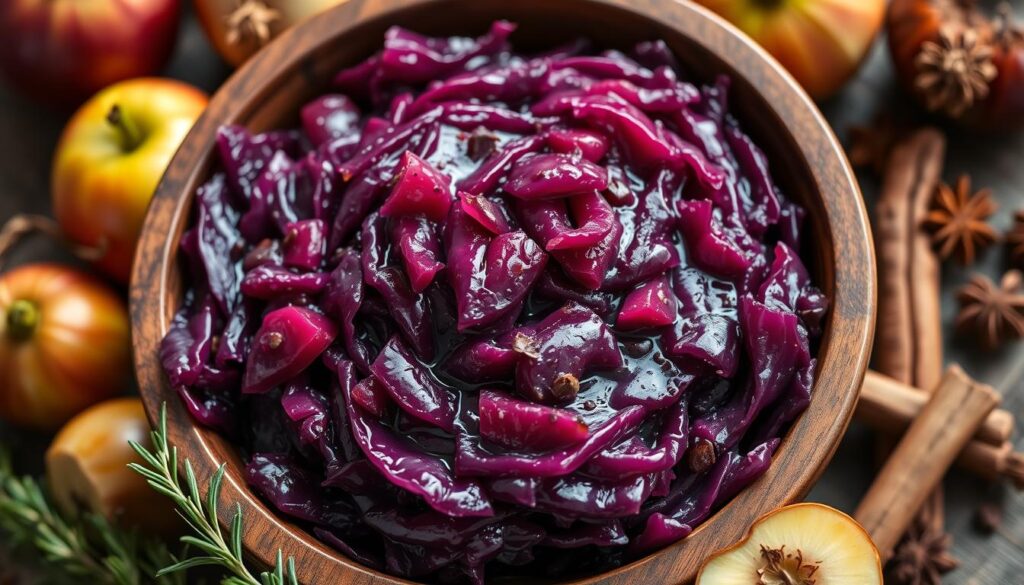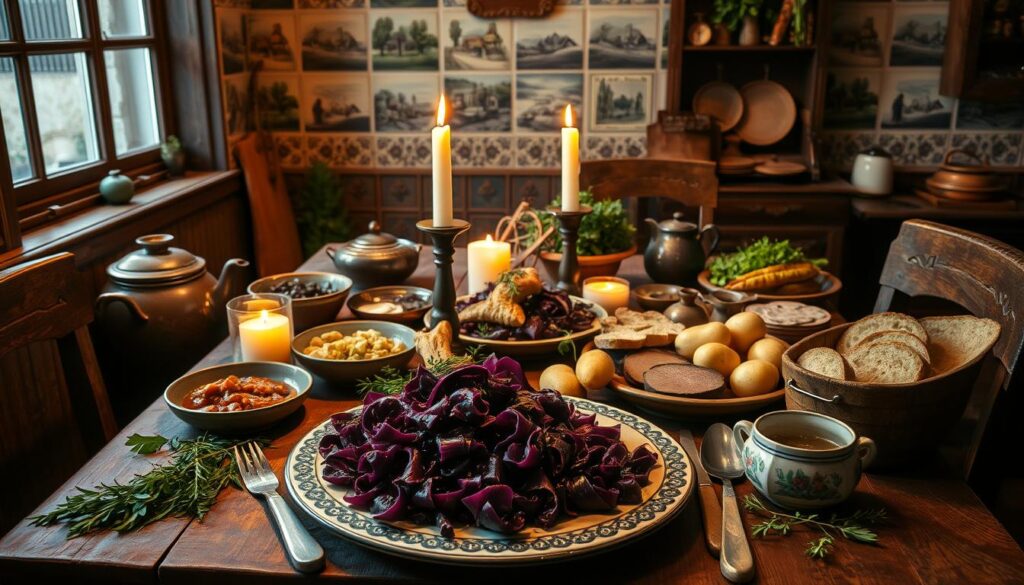Remember those family gatherings that made your heart feel warm? The laughter and meals shared are unforgettable. German Red Cabbage often adds to these memories. It’s a key part of traditional German food, known for its sweet and sour taste.
Think of biting into tender red cabbage, flavored with apples and vinegar. This dish has been loved for generations. It’s perfect with a roast or enjoyed on its own. Let’s explore the history and flavors of German Red Cabbage together. It’s a chance to make new memories at dinner.
Table of Contents
Key Takeaways
- German Red Cabbage is a nutrient-dense vegetable packed with vitamins A, C, and potassium.
- It is low in calories and a great source of dietary fiber.
- This dish can be stored in the refrigerator for up to five days.
- Freezing German Red Cabbage extends its life to three months.
- It can be served warm or cold, making it versatile for various meals.
- The recipe serves about 8 people and takes a total cooking time of 3 hours.
What is German Red Cabbage?
German red cabbage, also known as Rotkohl, is a vibrant dish in traditional German cuisine. It combines sweet and sour flavors, making it great with hearty meals. This dish is especially popular in autumn and winter.
The preparation of braised red cabbage involves simmering it with a mix of ingredients. Ingredients like unsalted butter, red onions, and tart Gala apples are common. Spices like cloves and juniper berries, along with apple cider vinegar, sugar, and kosher salt, add to the flavor.
Cooking German red cabbage takes 1.5 to 2 hours. This time allows the flavors to blend well. It’s tender and flavorful, perfect with roasted meats or sausages. Leftovers can be stored in the fridge for up to 4 days or frozen for 3 months.

Across Germany, there are many variations of Rotkohl. People can get creative with ingredients and spices. But, German red cabbage is always a beloved dish, showing the heart of German cooking.
History of Red Cabbage in German Cuisine
Rotkohl, or red cabbage, has a long history in Germany, dating back to medieval times. It became a favorite side dish during festive times. Families saw traditional German food as key to cultural gatherings, with Rotkohl often paired with roasted goose or schnitzel.
Cabbage, especially red varieties, became more important over the centuries. It was a staple in central, northern, and eastern Europe from the 17th to the 18th centuries. Germany’s climate made it perfect for growing, with most harvests happening in fall and winter. This shows how German cooking made the most of nature’s offerings during cold seasons.
By the 20th century, dishes with Rotkohl became a big part of German cooking. This highlighted the vegetable’s rich history. Breeding made it better for storage, frost, and nutrition, keeping it a key part of German cuisine.

The world has seen amazing records with cabbage. The Guinness Book of World Records has the heaviest red cabbage at 31.6 kilograms (69 lb 11 oz). Today, cabbage is grown worldwide, with China leading in production. As you learn about Rotkohl, see how it’s stayed important in German food and kitchens everywhere.
Ingredients for Traditional German Red Cabbage
A traditional German red cabbage recipe combines flavors for its unique taste. Here are the key ingredients for a delicious dish:
- 1 medium head of red cabbage
- 2 tart apples (such as Granny Smith)
- 1 yellow onion
- 1 cup apple cider vinegar
- 2 tablespoons sugar
- 1 tablespoon butter
- 2-3 bay leaves
- Whole cloves (optional)
This mix of ingredients, with tart apples and vinegar, offers a sweet and sour balance. Apples add richness, making a thick sauce that goes well with many meals. You can also try cherry or blueberry jam, different vinegars, to make it your own.
The table below shows the nutritional info per serving. It helps you understand the health benefits of this tasty side dish:
| Nutritional Value | Per Serving |
|---|---|
| Calories | 115 kcal |
| Carbohydrates | 23g |
| Protein | 2g |
| Fat | 0.4g |
| Sodium | 44mg |
| Potassium | 439mg |
| Fiber | 5g |
| Sugar | 14g |
| Vitamin C | 84mg |
How to Make German Red Cabbage
Making German red cabbage is easy and rewarding. This side dish is full of flavor and pairs well with many meals. You’ll enjoy making it at home.
Step-by-Step Cooking Process
- Start by shredding 8 cups of red cabbage into thin slices with a mandolin slicer.
- In a big pot or Dutch oven, melt 2 tablespoons of butter. Then, sauté 1 medium diced onion and 3 chopped apples until they’re soft.
- Add the shredded cabbage, 3 tablespoons of apple cider vinegar, 5 tablespoons of brown sugar, 1/8 teaspoon of salt, and some freshly ground pepper to the pot.
- Cover and cook on low heat for about 1 hour and 10 minutes. Stir every now and then to cook evenly.
- When the cabbage is tender, taste and adjust the seasoning as needed before serving it warm.
Essential Tips for the Perfect Dish
For the best results, keep these tips in mind:
- Use fresh, high-quality ingredients for better flavor.
- Cut the vegetables evenly for even cooking.
- Let it cook slowly to fully develop flavors and achieve a tender texture.
- Try adding lingonberry jam or cranberry sauce for a sweet and tart twist.
- Regularly taste the dish while cooking to adjust the seasoning to your liking.
This dish is not only nutritious but also delicious. It’s rich in fiber and low in calories. It’s a favorite in Germany, Scandinavia, and northern Europe. With about 178 calories per serving, it’s a healthy and tasty addition to your meals.
| Ingredient | Amount |
|---|---|
| Chopped red cabbage | 8 cups |
| Chopped apples | 1 and 1/2 cups |
| Cider vinegar | 1/4 cup |
| Brown sugar | 5 tablespoons |
| Raisins | 1/4 cup |
| Salt | 1/8 teaspoon |
| Ground pepper | To taste |
The Sweet and Sour Flavor Profile
The sweet and sour red cabbage is known for its unique taste. It mixes tartness from apple cider vinegar, sweetness from light brown sugar, and the earthy taste of red cabbage. Thinly sliced red onion adds even more flavor, making it hard to resist.
Cooking the cabbage slowly is key. This slow cooking lets the natural sugars caramelize, adding depth to the dish. After about 30 minutes, the juices become syrupy, revealing the sweet and sour taste.
Each serving has about 186 calories, making it tasty and healthy. It’s packed with vitamins, making it a great choice for a balanced diet. Sweet and sour red cabbage is perfect for those who love traditional flavors and want to eat well.
Serving Suggestions for German Red Cabbage
German Red Cabbage is loved for its bright flavor and color. It’s a favorite side dish in many homes. Its versatility makes it great with many main courses, perfect for both everyday meals and special occasions.
Pairing with Traditional German Dishes
This side dish pairs well with traditional German dishes. Try it with:
- Sauerbraten
- Beef rouladen
- Roasted meats such as duck and goose
These hearty meals get a nice contrast from the sweet-and-sour German Red Cabbage. Adding dumplings, like potato or bread, makes it even more authentic.
Alternative Meal Pairings
Looking for alternative meal pairings? German Red Cabbage fits well in different cuisines. Here are some ideas:
- Grilled sausages
- Roasted chicken
- Tacos
- Cheese sandwiches
- Warm salads or as a topping for avocado toast
This side dish is budget-friendly and can make winter stews taste better. It’s also great in rice bowls. You can prepare it ahead of time and even freeze it. It’s a great choice for any meal, as a condiment or a main side.
Recipe Variations for Authentic Red Cabbage Dish
The classic German red cabbage recipe is loved by many. But, you can make it even better by trying different variations. Each change can match your taste and add a new twist to this dish.
Start by adding different spices for a unique taste. Spices like allspice or cumin can give your dish a warm flavor.
If you prefer something lighter, try using less sugar or different sweeteners. Adding fruits can also be great. Use seasonal fruits to add a fresh taste. Try using fruity vinegars for a deeper flavor.
| Ingredient | Traditional Use | Variation Options |
|---|---|---|
| Red Cabbage | Base ingredient | Shred for even cooking; try savoy cabbage for a tender alternative |
| Apples | Typically Gala or Honeycrisp | Use pears or dried fruits like raisins for variation |
| Vinegar | Apple cider vinegar | Try balsamic vinegar for a different taste |
| Fats | butter | Alternative oils or duck fat may yield interesting results |
| Sweetener | Sugar | Reduce sugar or use maple syrup as a natural sweetener |
These variations let you make the red cabbage dish your own. Feel free to try new flavors and adjust ingredients to your liking. Every small change can create a new and exciting version of this German classic.
Health Benefits of German Red Cabbage
Adding German red cabbage to your meals brings many health perks. It’s full of nutrients, making it great for your diet. It’s rich in vitamins A and C, boosting your immune system and eyesight. It also has lots of fiber, helping your digestion and keeping your bowels regular.
Red cabbage has antioxidants like anthocyanins and sulforaphane. These help fight inflammation and may lower the risk of chronic diseases. Plus, an 80g serving has just 12 kcal. This makes it a guilt-free choice, and it counts as one of your daily five-a-day servings.
- Supports heart health, potentially lowering the risk of heart attacks and heart disease-related deaths.
- Contains anti-cancer compounds that may reduce the risk of certain cancers, including colorectal cancer.
- Acts as a prebiotic, promoting healthy gut bacteria and overall gut health.
Red cabbage is not just tasty; it’s also a health powerhouse. Enjoy it raw in a slaw or cooked, and you’ll see its many benefits.
How to Store and Reheat Leftover Red Cabbage
Proper storage of leftover red cabbage keeps its taste fresh. Cool it down to room temperature first. Then, put it in an airtight container. This keeps it fresh and stops other smells from getting in.
There are easy ways to reheat red cabbage. You can warm it gently on the stovetop or in the microwave. If you want to freeze it, it can last up to three months. Just thaw it in the fridge overnight for the best taste and texture.
Here’s a quick guide to storing and reheating red cabbage:
| Method | Storage Duration | Reheating Options | Notes |
|---|---|---|---|
| Refrigerator | Up to 5 days | Stovetop, microwave | Keep in an airtight container |
| Freezer | Up to 3 months | Stovetop, oven, air fryer, microwave | Thaw overnight in the refrigerator |
These methods help keep your leftover red cabbage tasty. It will be ready for your next meal.
Conclusion
German red cabbage is more than a side dish. It’s the heart of traditional German cooking, bringing warmth and richness to every meal. Its sweet and sour taste enhances many dishes, making it a must-have at any table.
It’s perfect for family dinners or for those who love cooking. This dish adds a special touch to your meals.
German red cabbage is also great for your health. It’s full of fiber, vitamins, and antioxidants. This makes it a smart choice for a healthy diet.
Its nutritional value and versatility let you make many different dishes. You can find something for everyone’s taste.
Adding German red cabbage to your meals is a win-win. It’s delicious and good for you. It’s perfect for those who want authentic flavors and healthy ingredients in their cooking.
Exploring German red cabbage connects you to traditional German tastes. It also supports a healthy lifestyle.
F.A.Q
-
What is German Red Cabbage?
German Red Cabbage, also known as Rotkohl or Blaukraut, is a vibrant side dish. It’s made from braised red cabbage, onions, and apples. It has a sweet and sour taste, simmered with vinegar and spices.
-
How do you make traditional German red cabbage?
To make it, shred the cabbage and sauté onions and apples in butter . Add the cabbage, vinegar, sugar, and spices. Cook on low heat for 1.5 to 2 hours, stirring now and then.
-
What dishes pair well with German Red Cabbage?
It goes great with Sauerbraten, and beef rouladen. It also pairs well with dumplings and grilled sausages or roasted chicken.
-
Can I modify the recipe for German Red Cabbage?
Yes! Try adding spices like allspice or cumin. You can also add nuts for extra flavor. For a lighter version, use less sugar or try different sweeteners. Adding seasonal fruits can add complexity.
-
What are the health benefits of German Red Cabbage?
It’s packed with vitamins A and C and fiber. It’s good for your digestive health and has antioxidants. These may help fight inflammation and chronic diseases, all while being low in calories.
-
How should I store leftover German Red Cabbage?
Cool it down, then put it in an airtight container. Store it in the fridge for up to five days or freeze for up to three months. Thaw in the fridge and reheat gently for the best taste and texture.



